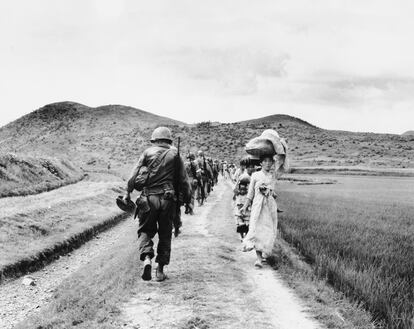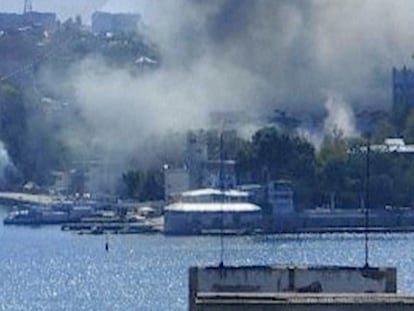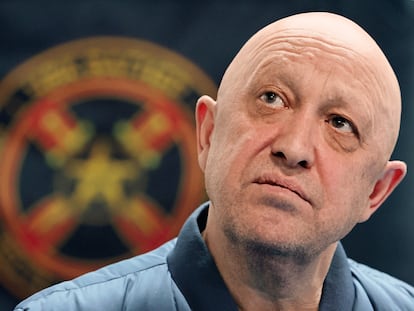Ukraine fears that the war will end in a divided country, like North and South Korea
Politicians and experts believe that, if neither side changes the balance of power on the frontlines, both attrition and international pressure could force a cessation of hostilities with a territorial split


A specter from the Cold War has appeared in the political debate about the future of Ukraine: the fear that the country will break in two, like what happened with the Korean peninsula. The stalemate on the frontlines — with neither the Russians nor the Ukrainians able to shift the balance of power — has led to more politicians and geopolitical experts noting that the possible cessation of the conflict may involve the kind of territorial split that occurred between North and South Korea. There could be a free Ukraine, which is integrated into the Western bloc, while another part of the country remains essentially annexed by Russia.
The end of World War II led to the division of the Korean Peninsula, which had – up until August of 1945 – been occupied by the Japanese Empire. The portion of the territory north of the 38th parallel would be protected by the Soviet Union, while the United States would take care of the south. After failed attempts at reunification, two new states were proclaimed in 1948: communist Korea and the Korea allied with the United States. North Korea invaded South Korea in 1950, which provoked a military intervention by mostly American troops under the auspices of the United Nations. China participated militarily in favor of North Korea, while the Soviet Union provided material support. In 1953, an armistice was signed by both countries, which temporarily ceased hostilities. It continues to be in effect to this day – no formal peace agreement was ever implemented.
The Korean scenario has always been on the table in the Ukrainian crisis. Numerous analyses have raised this possibility since 2022. However, it has only been this year that the fear of a partition of Ukraine has progressively taken shape. Last January, Oleksii Danilov – secretary of Ukraine’s National Security Council – warned: “We are being offered the Korean option. ‘Here there will be some Ukrainians, here there will be other Ukrainians and here there shall be no Ukrainians.’ I’m convinced that one of the options they will offer us is this 38th parallel.” Oleksii Arestovich – a well-known Ukrainian public commentator and former advisor to President Volodymyr Zelenskiy – stressed the issue in February of 2023: the country could end up “in a two-Koreas scenario.” “The worst thing of all,” Arestovich added, “is that the West thinks that this is possible… and we’re totally dependent on them.”
The words of Danilov and Arestovich were spoken before the Ukrainian counteroffensive began in June. Since then, the expectations of success have been disproven. Russia continues to occupy at least 18% of Ukrainian territory. This is the same percentage as in November of 2022, since the last victorious Ukrainian counteroffensive, when half of the province of Kherson was liberated.
Former US President George W. Bush (2001-2009) brought up the Korean option at the annual meeting of the Yalta European Strategy (YES) conference on September 8, in Kyiv.
In his speech, Bush raised the possibility that the war could divide the country and never formally end – just like with what happened in the Korean Peninsula. When asked if Ukraine should give up part of its territory to achieve peace, Bush responded that this was a decision that the Ukrainians had to make. He added that the United States and the rest of Ukraine’s allies would continue to support them whether they opted for such an option, or chose to continue fighting.
Backroom negotiations
Both Zelenskiy and the high command of the Ukrainian Armed Forces have asked for more time, even if the war takes years. But not all of Kyiv’s international partners are on board with this, as the president himself has acknowledged. In his speech before the UN General Assembly on September 19, the Ukrainian president said he was “aware of attempts to reach shady [peace] pacts behind closed doors.” In an interview with The Economist from earlier in September, Zelenskiy admitted that he had detected a change in some of the international leaders with whom he meets regularly: “I have this intuition – by reading them, listening and looking into their eyes – when they tell me ‘we will always be with you’ that he or she is no longer here, he or she is not with us.”
This past Wednesday, there was a clear example of the fragility of these alliances. Poland — one of Ukraine’s most unconditional supporters in the war — caused an earthquake. Polish Prime Minister Mateusz Morawiecki – angered over a dispute with Ukraine over agricultural imports – announced that there would be no new weapon shipments to Ukraine, beyond what has already been agreed to. Meanwhile, Polish President Andrzej Duda even compared his neighboring country to a desperate person, who drags those who want to help him to their death. “It’s as if we’re dealing with a drowning person. Anyone who has tried to help someone who is drowning knows that it’s extremely dangerous, because they can drag you into the depths.”
Four possible options for the future of Ukraine
A gloomy report about the future of Ukraine was presented at the annual meeting of the YES group. The document – which was prepared by Ukrainian politicians and summarized by MP Oleksii Zhmerenetskii – offers up four possibilities for the future (predicting up until the year 2040). Only one of these is positive.
The first possibility establishes that Russian domination could lead to a world war if the invading country were to attack another Black Sea nation. The second option indicates that – after Ukraine is forced to agree to a ceasefire by ceding territory – widespread anger will bring ultranationalist groups to power and turn the country into an autocracy. The third option foresees Ukraine disintegrating into multiple autonomous regions. The fourth option – the sole positive one – contemplates Ukraine winning the war and expelling the Russians from its territory.
The Korean scenario would be part of the second option, which predicts the serious danger that is democratic reversal in Ukraine. In fact, an advisor to the Slovak Foreign Ministry explained to EL PAÍS that one of his government’s main concerns is that, when the time comes to force negotiations between the two sides, Ukraine will take an authoritarian path.
Winning the peace
There are academics who are arguing that the Korean option may be the least bad for Ukraine. The main supporter of this thesis is Stephen Kotkin, one of the most recognized experts on the history of the Soviet Union and modern Russia. From the Hoover Institution at Stanford University, Kotkin argues that the time has come for Ukraine “not to win the war, but to win a lasting peace.” In an August 25 interview with War on the Rocks – one of the most widely-read online media outlets analyzing the war in Ukraine – Kotkin stated that the events on the battlefield prove that the moment of euphoria has passed and the Russian army “didn’t fall apart.”
For Kotkin, a Ukrainian victory is joining the European Union and establishing a new security model, whether within NATO or via a defense agreement, similar to the one that South Korea has with the United States. “Do you need the entire territory for this?” Kotkin asks. He’s no longer sure that this is possible, not only in terms of military resources, but also in terms of the social reality of the areas annexed by Russia with the support of separatists in the Donbas. “In Crimea (the Black Sea peninsula illegally annexed by Russia in 2014), there are already more than two million Russians. If Crimea is liberated, will these Russians be expelled? Will there be ethnic cleansing, like what the Russians carried out against the Tatars (the native people of Crimea)? Because these [separatists could make up] a potential insurgency.”

“South Korea doesn’t have all the territory, but it [gained] security after the armistice,” Kotkin explained, at a conference organized by the Hoover Institution this past July. “It’s an imperfect solution, because it left many families divided… but South Korea is now one of the most prosperous societies in the world. Ukraine can follow this path.”
The division of Germany
Kotkin isn’t the only one who thinks this way. In a debate organized on September 8 by NPR, prominent experts were betting on the same thing. Carter Malkasian – chair of the Defense Analysis Department at the Naval Postgraduate School – stated that “the Korean armistice model could be the best option, although nothing guarantees its success.” Jong Eun Lee – a retired South Korean military officer and professor of Political Science at North Greenville University – acknowledged that “while it’s controversial to say it, after such a long division – which has left [the Koreas] in a place of cultural and political difference – [division was], economically speaking, perhaps better than starting a war.”
The German case has also been widely used to understand what the future holds for Ukraine. However, there are notable differences, because the two German states – like the two Koreas – were both recognized internationally. Furthermore, there was no armed conflict between East and West Germany. The German case is used by Kyiv to demonstrate that, despite the Russian occupation of part of its territory, free Ukraine can be a member of NATO, just like the Federal Republic of Germany once was.
Malkasian reiterated another factor that all the military analysts consulted in recent months by EL PAÍS have agreed on: “Negotiations will be possible as the fighting continues and both sides become exhausted, accumulating large losses.” But Malkasian stressed that the only way for peace negotiations to take place in the future is precisely through long-term military support from Ukraine’s allies in NATO, because “it’s the only way for Ukraine to maintain its position and exert pressure on Russia.”
In August, John Feffer – a fellow at the DC-based Institute for Policy Studies – wrote that, “without a major Ukrainian military advance or without a major political change in Russia, the two sides will find themselves in the same situation as the Korean forces in 1953: stuck along a [frontline] that’s making little progress, either in favor of one side or another.” Feffer believes that after enormous wear and tear on both armies predisposes them to negotiate, the international community will be able to propose an armistice. But Feffer is less than optimistic about an end to hostilities. Firstly, because – unlike with the two Koreas – the borders of the territories annexed by Russia aren’t recognized by international law. And experience – according to him – shows that “Russia – as it did in Georgia and Moldova – will just use the situation to destabilize Ukraine.” Ukraine, for its part, “will want to convince the population of the occupied eastern territories to reunify and become part of prosperous Europe.”
A fortress state
In numerous speeches, the president has declared that Ukraine must militarize itself for a life in constant threat, while developing an anti-aircraft defense system that allows its cities to develop, despite periodic Russian bombings. However, Kotkin has criticized this idea of transforming Ukraine “into a fortress state” because “it doesn’t help achieve lasting peace.” He also adds that this model wouldn’t match the requirements for EU membership.
This raises another question: could Ukraine be a member of the European Union, if it’s engaged in a permanent military conflict with Russia? Ukrainian Foreign Minister Dmitro Kuleba answered this question in an interview with EL PAÍS, in July of 2022: Cyprus – which has part of its territory occupied by Turkey – is a member of the EU. “Europe is full of conflicts that remain under the layer of endless negotiations,” Kuleba noted. “I’m sure that, if there’s a will to find a political solution, there will be a way for Ukraine to become a member of the EU.”
Sign up for our weekly newsletter to get more English-language news coverage from EL PAÍS USA Edition
Tu suscripción se está usando en otro dispositivo
¿Quieres añadir otro usuario a tu suscripción?
Si continúas leyendo en este dispositivo, no se podrá leer en el otro.
FlechaTu suscripción se está usando en otro dispositivo y solo puedes acceder a EL PAÍS desde un dispositivo a la vez.
Si quieres compartir tu cuenta, cambia tu suscripción a la modalidad Premium, así podrás añadir otro usuario. Cada uno accederá con su propia cuenta de email, lo que os permitirá personalizar vuestra experiencia en EL PAÍS.
¿Tienes una suscripción de empresa? Accede aquí para contratar más cuentas.
En el caso de no saber quién está usando tu cuenta, te recomendamos cambiar tu contraseña aquí.
Si decides continuar compartiendo tu cuenta, este mensaje se mostrará en tu dispositivo y en el de la otra persona que está usando tu cuenta de forma indefinida, afectando a tu experiencia de lectura. Puedes consultar aquí los términos y condiciones de la suscripción digital.
More information
Archived In
Últimas noticias
Most viewed
- Sinaloa Cartel war is taking its toll on Los Chapitos
- Oona Chaplin: ‘I told James Cameron that I was living in a treehouse and starting a permaculture project with a friend’
- Reinhard Genzel, Nobel laureate in physics: ‘One-minute videos will never give you the truth’
- Why the price of coffee has skyrocketed: from Brazilian plantations to specialty coffee houses
- Silver prices are going crazy: This is what’s fueling the rally










































